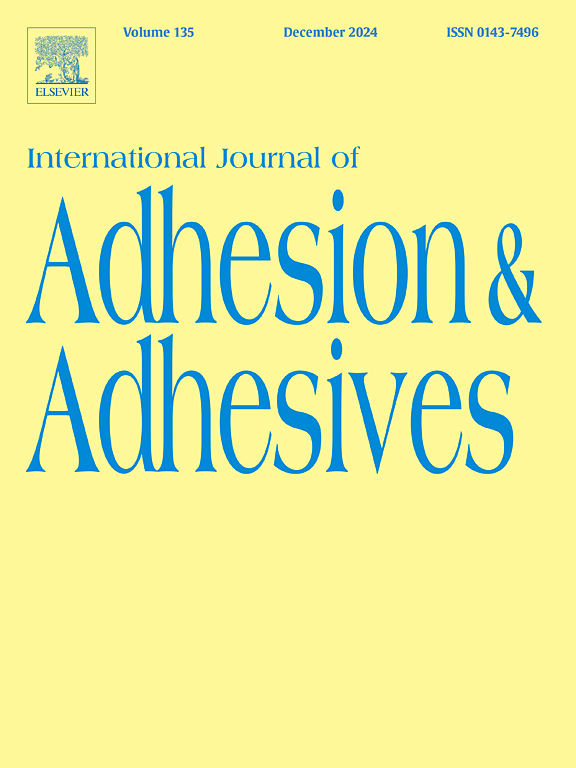Impact of radiation therapy regimen on the dislodgement resistance of endodontic sealers: A micro push-out test
IF 3.2
3区 材料科学
Q2 ENGINEERING, CHEMICAL
International Journal of Adhesion and Adhesives
Pub Date : 2024-11-19
DOI:10.1016/j.ijadhadh.2024.103894
引用次数: 0
Abstract
Purpose
This study aimed to assess the impact of the radiation therapy regimen on the dislodgement resistance of endodontic sealers of different bases through a micro push-out test.
Materials and methods
Dentin slices were obtained from the cervical and middle root thirds of bovine incisors and distributed into three groups, according to the radiation therapy regimen (n = 30): non-irradiated; 50 Gy; and 70 Gy. Three 1.0 mm diameter root canal-like cavities were made in each dentin slice. Each cavity was filled with the following sealers: AH Plus Jet (epoxy resin), BioRoot RCS (bioceramic) and Endofill (zinc oxide). After 7 days, a micro push-out test was performed in a Universal Testing Machine. Failures were analyzed using a stereomicroscope. Statistical analysis included the application of Three-Way Analysis of Variance (ANOVA) followed by Bonferroni's post-hoc test (α = 5 %).
Results
Non-irradiated specimens filled with AH Plus Jet and BioRoot RCS had higher bond strength than the irradiated ones, regardless of the radiation therapy regimen (p < 0.001). There were no differences between specimens irradiated with 50 Gy and 70 Gy for AH Plus Jet and BioRoot RCS (p > 0.05). There were no differences among non-irradiated and irradiated specimens for Endofill at the cervical third (p = 0.406). Cohesive failure was the most frequent before irradiation. After irradiation, mixed failure was the most frequent.
Conclusion
Radiation therapy reduced the bond strength of both epoxy resin and bioceramic sealers. The zinc oxide-based sealer exhibited the lowest dislodgement resistance, making it a less suitable option for patients undergoing radiotherapy.
放射治疗方案对牙髓密封剂抗脱落性的影响:微型推出试验
材料和方法从牛门牙的颈根和中根三分之二处获取牙本质切片,并根据放射治疗方案(n = 30)分为三组:未照射组、50 Gy 组和 70 Gy 组。在每个牙本质切片上制作三个直径为 1.0 毫米的根管样空腔。每个龋洞都用以下封闭剂填充:AH Plus Jet(环氧树脂)、BioRoot RCS(生物陶瓷)和 Endofill(氧化锌)。7 天后,在万能试验机上进行微推挤试验。使用体视显微镜对故障进行分析。统计分析包括应用三方方差分析(ANOVA),然后进行 Bonferroni 的事后检验(α = 5 %)。结果无论采用哪种放射治疗方案,用 AH Plus Jet 和 BioRoot RCS 填充的非辐照试样的粘接强度都高于辐照试样(p <0.001)。对于 AH Plus Jet 和 BioRoot RCS,50 Gy 和 70 Gy 照射下的试样之间没有差异(p > 0.05)。颈椎三分之一处的 Endofill 在未接受辐照和接受辐照的标本之间没有差异(p = 0.406)。辐照前,内聚失效最为常见。结论辐照治疗降低了环氧树脂和生物陶瓷封闭剂的粘结强度。氧化锌封闭剂的抗脱落性最低,因此不太适合接受放射治疗的患者。
本文章由计算机程序翻译,如有差异,请以英文原文为准。
求助全文
约1分钟内获得全文
求助全文
来源期刊

International Journal of Adhesion and Adhesives
工程技术-材料科学:综合
CiteScore
6.90
自引率
8.80%
发文量
200
审稿时长
8.3 months
期刊介绍:
The International Journal of Adhesion and Adhesives draws together the many aspects of the science and technology of adhesive materials, from fundamental research and development work to industrial applications. Subject areas covered include: interfacial interactions, surface chemistry, methods of testing, accumulation of test data on physical and mechanical properties, environmental effects, new adhesive materials, sealants, design of bonded joints, and manufacturing technology.
 求助内容:
求助内容: 应助结果提醒方式:
应助结果提醒方式:


